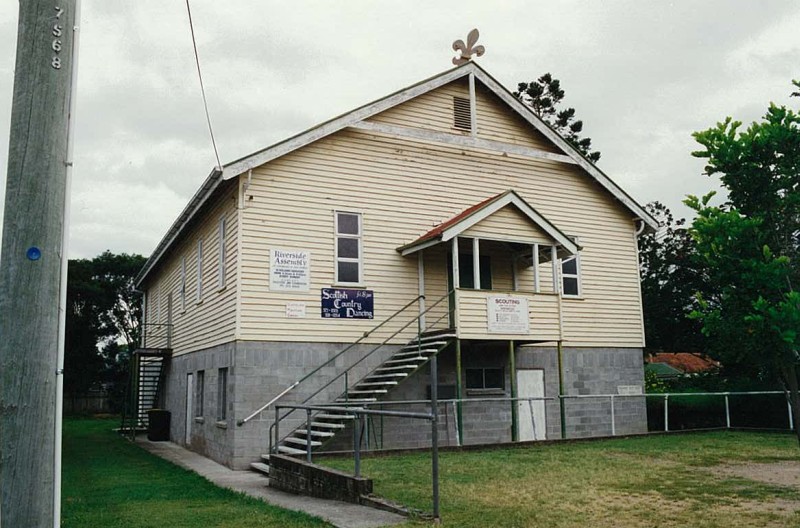Addresses
Type of place
Hall
Period
Interwar 1919-1939
Style
Queenslander
Addresses
Type of place
Hall
Period
Interwar 1919-1939
Style
Queenslander
This scout hall was constructed in 1927 and has been in constant use by Sherwood district scouts and other community groups since that time. It has special significance for residents who were involved in the scouting movement in Sherwood and also for residents who took part in other events and activities staged at the hall.
Lot plan
L1_RP153028
Key dates
Local Heritage Place Since —
Date of Citation —
Construction
Roof: Corrugated iron;Walls: Timber
Criterion for listing
(A) Historical; (G) SocialInteractive mapping
Lot plan
L1_RP153028
Key dates
Local Heritage Place Since —
Date of Citation —
Construction
Roof: Corrugated iron;Walls: Timber
Criterion for listing
(A) Historical; (G) SocialInteractive mapping
History
In 1907 the Scouting movement began in England, the brainchild of Major-General Robert Baden-Powell, who visited Brisbane in 1912. Brisbane groups first developed in 1908, the year that “Scouting for Boys” was published. From records held at the Queensland Scout Centre, it appears that 4 patrols were formed in 1908, at Kangaroo Point, Bowen Hills, Ashgrove and Toowong. In 1909, scoutmasters were appointed for 9 locations, plus there were at least 5 other troops active.
From 1910, records are based on the first issue of a warrant for a troop. In that year, 11 troops were formed. 1911 saw the formation of 6 troops; 1912 and 1913 had 3 each, and 2 were formed in 1914, including the Sherwood Troop, on 24th October. Another 98 troops were formed from 1915 to 1925. However, of the 123 troops formed from 1910-1925, only 33 were still extant by 1961.
An unofficial Sherwood Scout Troop may have been formed around 1910-11, since pioneering Scout Master Lesleigh John “Pal” Williams was apparently involved with the Sherwood troop before becoming Indooroopilly’s Scout Master in 1911. A 1990 newspaper article also refers to the “80th” anniversary for Sherwood Scouts 1910. However, the official Diamond Jubilee (60 years) was held in October 1974.
The Sherwood Scouts were reformed after WWI, meeting in May 1920. Until a den was built meeting places included the Sherwood Picture theatre, the Church of England Hall, and the Graceville Picture Theatre.
The Sherwood District Scout Hall was opened by Mayor William Jolly on March 19th, 1927, on land donated by James Edgar Young and Ruby Alice Young. Ruby had purchased 5 acres and 1 rood (sub 6 of portion 20) in 1911. The land was subdivided from 1917, and in 1924 three trustees were appointed for the 34 and 4/10 perch property on which the Hall was built. A new title was then issued for the trustees: James Edgar Young, Thomas Murray Hall and Manor Charles Trotter.
In 1926 title returned to Ruby, and Francis Desmond Power replaced Manor Charles Trotter as a trustee. The hall appears on the BCC Building Register on 23rd October 1926, and a mortgage was taken out in December 1926. Over the years death or retirement took its toll of most trustees, with new appointees being listed in 1931, 1945, 1956, 1962, 1979, 1990 and 1991.
The Sherwood Scout Hall seems unique amongst Queensland’s Scout halls in that the land does not belong to the Queensland Scout Association, nor is it leased. In fact, the original trust terms specify that the land should never come under the control of the Boy Scouts Association, and that it would be used for the sole benefit of any existing Sherwood Scout Troop, or if they were disbanded, a similar youth organisation.
As for the hall itself, since no arrangement with the Scout Association existed at the time (whereby the land was leased from the trustees, and the hall remained the property of the Scout Association), the trustees could claim ownership of the hall, even though it was built by the Sherwood Scouts.
Note: The ground floor of the building has also been altered. A newsletter in 1974 noted that the lower floor lacked headroom and was prone to flooding. Plans were made to raise the hall by 75cm and reset it on new concrete masonry walls. A new floor 30cm above the original, and improved drainage on the property, was also intended to help with the flooding problem.
Statement of significance
Relevant assessment criteria
This is a place of local heritage significance and meets one or more of the local heritage criteria under the Heritage planning scheme policy of the Brisbane City Plan 2014. It is significant because:
References
-
Department of Natural Resources and Mines, Queensland Certificates of Title
-
Walter Taylor South Character and Heritage Study, BCC Heritage Unit, 1997
-
Queensland Post Office Directories
-
Queensland Scout Centre Archives, Auchenflower
-
Brisbane City Council Department of Works Building Register 1925-1945
-
Around the Campfire: An Illustrated History of Indooroopilly Scouts, 1909-1991
-
Lexie Smiles, Greg de Silva. 2000
-
Courier Mail, 19 March 1927
Citation prepared by — Brisbane City Council (page revised June 2022)

